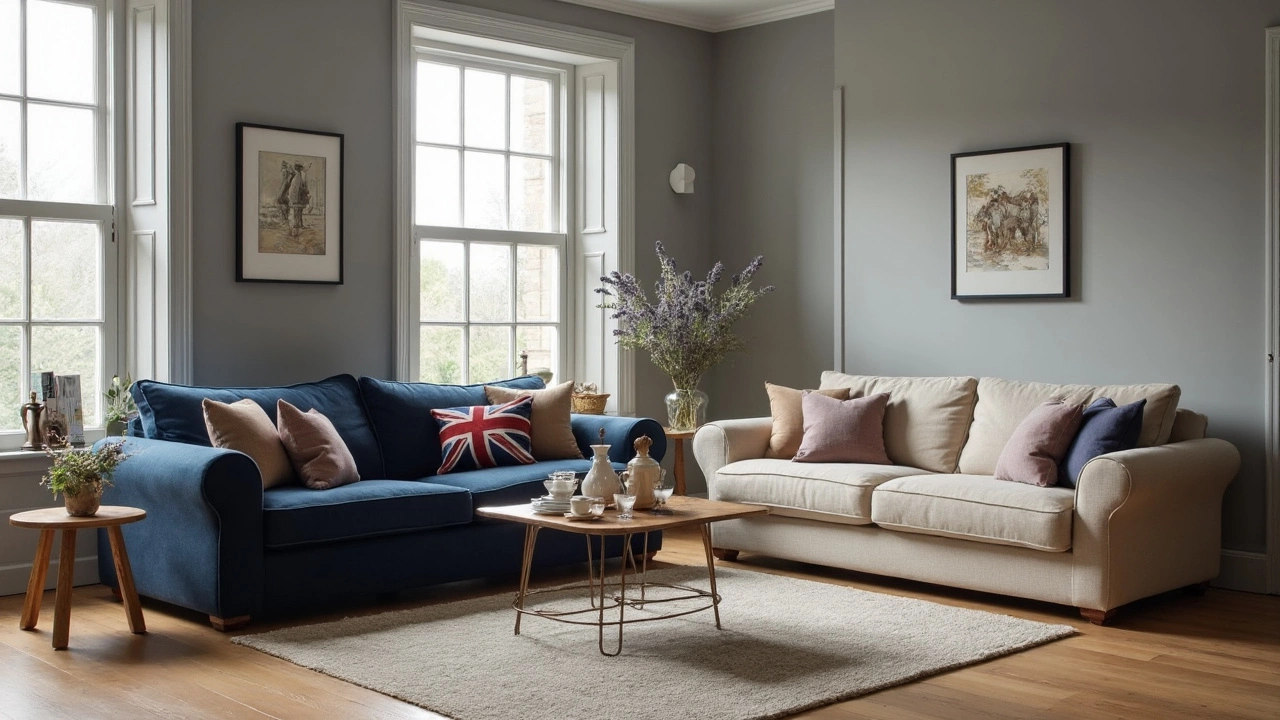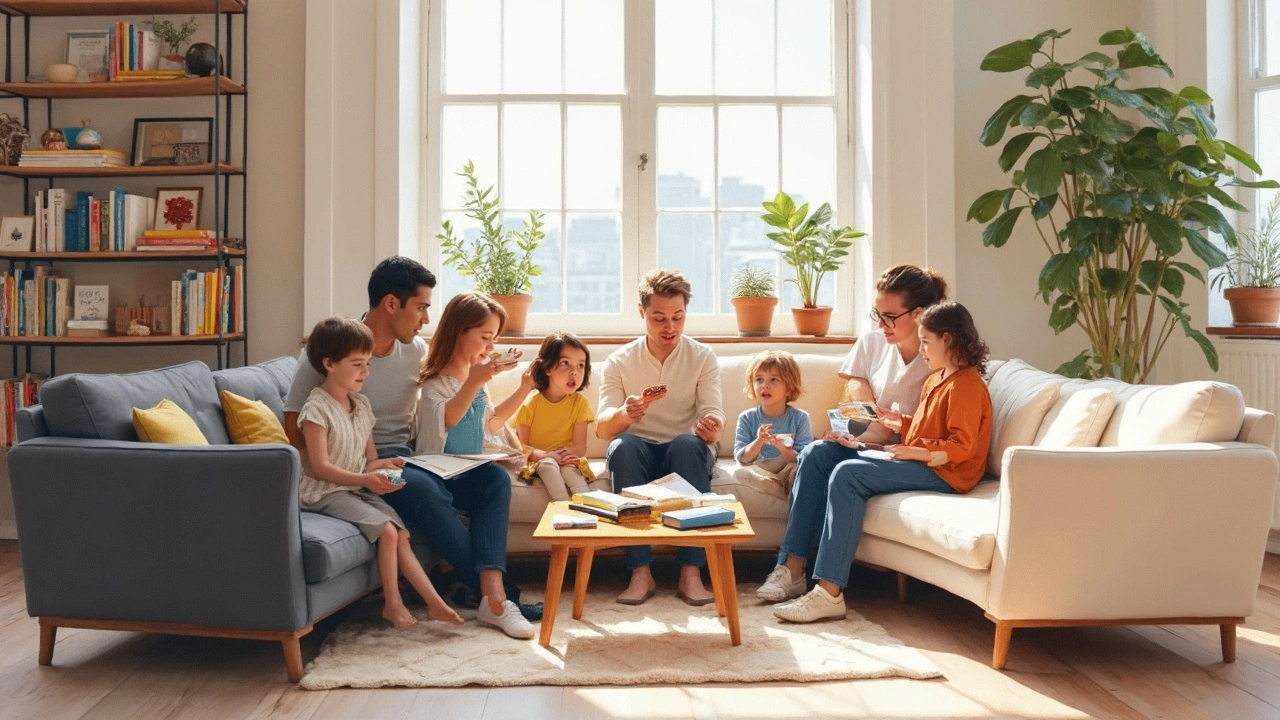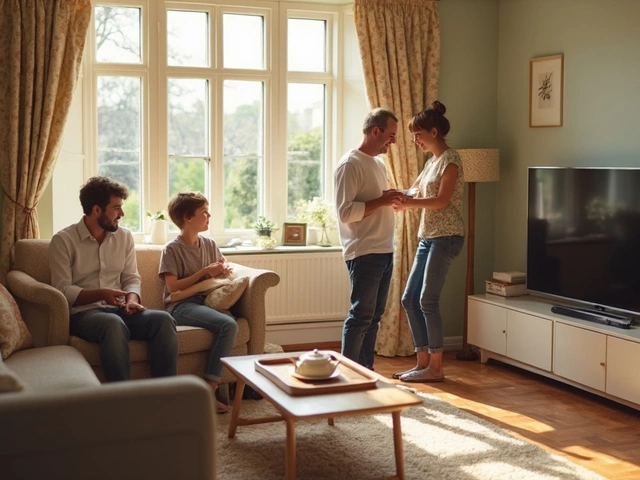 19
Jun,2025
19
Jun,2025
Stuck choosing between a lighter or darker sofa than your walls? You're not alone. This is one of those classic decorating dilemmas. Here’s the thing—your sofa acts like the anchor of the whole room. Pick the wrong color, and suddenly the space feels off, no matter how nice everything else is.
Before you buy anything, look beyond just what “looks good” in a store. A lighter sofa can make your living room look open and airy, but sometimes it vanishes, especially if your walls are already pale. Go too dark, and it might make your room feel heavy or close in on itself. On the flip side, a deep-colored sofa is like a statement—a bold move that grabs attention, but it can be trickier to match with the rest of your stuff.
If you want your living space to look bigger or more relaxed, most folks find that one should usually be a few shades lighter or darker than the other for contrast. But don’t stress—there’s no one-size-fits-all answer. What you need is a few simple tricks and real-life examples to make the decision less overwhelming. We’ll dig into how your room’s size, lighting, and your lifestyle all play a part in what looks (and lives) best. Ready to figure out the right move for your space?
- Light Sofas vs. Dark Sofas: The Basics
- How Room Size and Light Matter
- Your Lifestyle and Maintenance
- Matching vs. Contrasting: What Actually Works
- Avoiding Common Color Mistakes
- Making the Choice: Fast Tips and Real-Life Examples
Light Sofas vs. Dark Sofas: The Basics
There’s a real difference in vibe between a light sofa and a dark one. Let’s break down what each option brings to the table, so you can dodge regrets and pick what fits your home.
A sofa color sets the mood. Lighter sofas—think off-white, beige, or pale gray—usually give a room a breezy, open feel. They reflect light, which means your space might look bigger and brighter, even on a cloudy day. If your walls are already light, a lighter sofa can blend in, helping everything feel seamless. But there’s the catch: light fabrics show stains, dirt, and pet hair much quicker. If you’ve got young kids, big dogs, or love movie nights with snacks, factor this in.
Dark sofas—deep blue, charcoal, forest green, espresso brown—pull the eye and can ground a busy room. They anchor your layout, so big pieces don’t look like they’re floating. Darker shades are forgiving with spills and day-to-day mess, which is why they’re a go-to in homes with lots of action. But dark sofas can make a small or dimly lit room feel more cramped if you don’t balance them with lighter walls or plenty of lighting.
Here’s a quick comparison:
| Light Sofa | Dark Sofa | |
|---|---|---|
| Room Feel | Airy, open, soft | Cozy, bold, grounded |
| Hides Stains? | No | Yes |
| Makes Room Look Bigger? | Yes | Not usually |
| Pops in Photos? | Can blend in | Stands out |
If you’re thinking resale, light sofas often pull more buyers on listing photos—but they’re not as forgiving once real life kicks in. Designers sometimes recommend mid-tones (like medium gray or muted green) for a safe blend, but if you love cleaning or have a “shoes off” rule, a lighter sofa can work fine. The key: match the sofa’s personality with your lifestyle, not just your paint color.
How Room Size and Light Matter
The size of your living room and how much natural light it gets can totally change the way your sofa and wall colors work together. For smaller rooms, a lighter sofa against light walls usually helps everything feel bigger and less cramped. On the other hand, if your walls are dark and your sofa matches, the whole place might start to feel like a cave—unless you get loads of sunlight streaming in during the day.
Here’s something that can help you right away: big, bright rooms can handle darker sofas, even if your walls are somewhat light. Large spaces swallow up some of that boldness, so things rarely feel over-the-top. If your room is on the small side, stick to sofas that are lighter than your walls, or at least not much darker—that way the sofa doesn’t look like a big block eating up all the space.
Check out this data on how color and space play together:
| Room Feature | Effect of Lighter Sofa | Effect of Darker Sofa |
|---|---|---|
| Small Room | Makes area look open and airy | Can feel crowded or busy |
| Large Room | Sometimes gets lost, feels plain | Adds depth and anchors room |
| Lots of Natural Light | Stays bright, fresh look | Strong color looks balanced |
| Low Natural Light | Prevents the space from feeling gloomy | Might make the room feel smaller |
One handy tip: always eyeball your room at different times of day. What feels cozy and cool when the sun’s out might feel totally different after dark. If your living room looks dark most of the day even with the lights on, lighter colors will help. Got a wall of windows? That opens the door to picking a bold, dark couch without worry.
So if you’re shopping during a furniture sale, take a few pictures of your living room in daylight and at night. Compare them with your sofa choices on your phone before you commit—it’s a trick that’s saved me more than once from buying the wrong thing.
Your Lifestyle and Maintenance
If you’ve got kids, pets, or a habit of eating pizza on the couch, the color decision goes way beyond style. Sofas in lighter shades show stains, dirt, and dog hair way faster than darker ones. A coffee spill on a white couch? It’s going to haunt you. But with a darker sofa, those daily disasters often blend right in until you have time to clean up. That’s why a lot of families with young kids or pets automatically lean dark.
But hey, lighter doesn’t always equal impossible maintenance. There are real-world fabrics (like certain microfiber or treated cottons) that shrug off messes with a quick wipe. And slipcovers can rescue even the lightest sofas—just toss them in the wash. On the other end, dark sofas can look dusty and show every bit of lint if you live in a spot with a lot of sunlight or have lighter-furred pets. It’s that little detail nobody tells you until you’re running the lint roller non-stop.
Some things to think about before locking in your color choice:
- If you’re trying to hide paw prints, go for patterns or textured fabrics. They disguise messes better than flat, solid colors.
- Light sofas need more frequent cleaning. If you hate extra chores, they might test your patience.
- With dark sofas in rooms with lots of sun, fading can be a real thing. Consider throws or rotate cushions to keep color even.
- Removable and washable covers? Game changer for both light and dark sofas. These add years to the life of your couch, no matter the shade.
When shopping, touch the fabric and ask about cleaning codes—some stores will even do a "spill test" for you. Ultimately, pick a sofa color that matches not just your style but your daily routine. Think about messes, cleaning habits, and who’s on the couch most. When you match your furniture to real life, you’ll thank yourself every weekend.

Matching vs. Contrasting: What Actually Works
If you’ve ever walked into a friend’s living room and thought, “Wow, everything just fits,” you’ve seen the power of playing with matching and contrasting colors. The most common trap? People try to match their sofa exactly to their walls. It sounds safe, but it usually makes the space look flat—like everything’s been dipped in the same bucket of paint. That’s not what you want, especially when you want your living room to have energy.
The best designers recommend going for contrast since contrast creates visual interest and helps your sofa color stand out just enough. Say your walls are light gray. A rich navy or deep forest green sofa can look stunning and lively. Flip it, and if your walls are charcoal or a deep blue, a light beige or off-white sofa can instantly lift the energy of the space.
Here’s a quick study-backed fact: According to a 2022 survey by Houzz, 69% of people said a room felt more “put together” when the main furniture piece contrasted with their wall color by at least two shades—not a subtle difference, but one you’ll notice as soon as you walk in. If you want even more of a pop, throw in some cushions with a completely different hue (think yellow on a blue sofa, or teal pillows on a taupe couch). It keeps things from getting too serious or monotone.
- Match for a subtle, calm vibe: Light sofa on light walls, dark on dark—good if you want your sofa to blend in and not shout for attention.
- Contrast for energy and focus: Light sofa on dark walls or the other way around—it draws the eye and acts as a focal point.
Having trouble picturing the difference? Check out this quick table showing how people report the “feel” of their space depending on their sofa/wall color combo:
| Wall Color | Sofa Color | Room Feel (surveyed users) |
|---|---|---|
| Light Beige | Dark Gray | Bold, modern, stately |
| Pale Blue | Off-White | Fresh, relaxed, airy |
| Charcoal | Light Tan | Balanced, inviting |
| White | Forest Green | Dramatic, lively |
| Soft Taupe | Taupe (matching) | Subtle, understated, safe |
Of course, there’s no rule that says you can’t break these “rules.” But if you’re hunting for a look that feels pulled together with minimal effort, contrast usually wins. Still not sure what to pick? Snap a photo of your wall and “drop in” a few virtual sofa colors using a room visualizer app—seeing the real thing can save a lot of guesswork (and regrets).
Avoiding Common Color Mistakes
Most people mess up the mix between sofa and wall colors because they follow trends or showroom setups without thinking about their actual space. Here’s where things usually go wrong—and how to avoid those headaches.
First up: don’t just match your sofa color to your paint exactly. You might think it’ll look polished, but the room just ends up bland and flat. Interior experts warn that going too matchy-matchy makes everything blend together, and you lose that pop of visual interest. What’s missing? Contrast. Try choosing a sofa that’s either noticeably lighter or noticeably darker than your walls for instant depth.
Another common pitfall: ignoring your floor color. If your sofa, walls, and floor are all similar shades, it all turns into one big blob. Rooms with mid-tone walls, dark hardwoods, and a light-toned sofa usually nail the right balance. Here’s a quick table comparing combinations and how they usually feel:
| Walls | Sofa | Floor | Room Feels |
|---|---|---|---|
| Light | Light | Dark | Fresh but sometimes bland |
| Light | Dark | Light/Medium | Crisp and inviting |
| Dark | Light | Medium | Airy but grounded |
| Dark | Dark | Light | Cozy and dramatic—sometimes too much |
Skipping large samples at home is another big misstep. Those tiny fabric swatches at the store are misleading. Colors change a lot under different lighting. Lay out larger samples next to your walls and see how both look in daylight and at night. If you’ve got pets or little kids, also test how easily the fabric picks up dust or stains—trust me, that’ll matter later.
One more thing: don’t forget about undertones. Sometimes a gray sofa looks blue next to your warm beige wall because of clashing undertones. Always compare both in your actual space instead of trusting your memory or just online photos.
- Go for obvious contrast, not exact matches.
- Check all three elements together: sofa, wall, floor.
- Test with real-life samples, not little swatches.
- Double-check undertones to avoid strange color vibes.
Avoid these typical mistakes and your living room will feel more put together, even if you change nothing else.
Making the Choice: Fast Tips and Real-Life Examples
So, how do you actually pull the trigger on picking either a lighter or darker sofa than your walls? The truth is, it comes down to the vibe you want, how much natural light you get, and what your room can handle. Let’s break down some easy, real-life tips that actually work.
Sofa color sets the whole mood in your living room. According to a report from Houzz in 2024, 72% of homeowners who picked a sofa color several shades different from their wall color said their living room felt “more stylish and welcoming.” Playing with contrast gives immediate impact.
- If your walls are light (think white, light gray, or pale blue), a darker sofa (like navy, charcoal, or deep green) grounds the space and hides stains or pet hair better.
- With darker walls (navy, charcoal, or dark green), a lighter sofa (cream, beige, or pale gray) gives the room a crisp, fresh look and doesn’t feel as “heavy.”
- For high-traffic spaces, darker sofas are usually more forgiving. If you have kids, dogs, or like hosting movie nights with snacks, you’ll stress a lot less about accidental spills.
- Renters or resale-minded owners—if you want to play it safe, go with a neutral sofa and a splash of color on the walls or with throws. It’s easier to swap out decor than replace a big piece of furniture.
Let’s check out some quick real-life examples. When Lucy and I moved into our last place, the living room had these chalky white walls. Our old beige sofa totally disappeared. Once we switched it for a deep teal one, even friends commented how the room finally “looked finished.” In my brother’s tiny city apartment, he went with a pale gray sofa against charcoal walls. It made his cramped spot feel lighter and less boxed-in.
If you like numbers, here’s a cheat sheet table based on what real people found worked best:
| Wall Color | Sofa Color | Room Effect | Best For |
|---|---|---|---|
| Light (white, greige) | Dark (navy, forest, charcoal) | Warm, cozy, anchored | Open rooms, families, pets |
| Dark (navy, black) | Light (cream, pale gray) | Airy, modern, bigger feel | Smaller rooms, apartments |
| Medium tones (taupe, sage) | Slightly lighter or darker shade | Balanced, relaxed, subtle | Flexible styles, renters |
Bottom line: The safest bet is to keep a contrast between sofa and walls—a gap of 2-4 shades looks best in most homes. If you’re stuck, look at photos of rooms you already like, or bring home fabric swatches and tape them up near your walls. Trust your gut and remember, you’re the one living with it every day.




